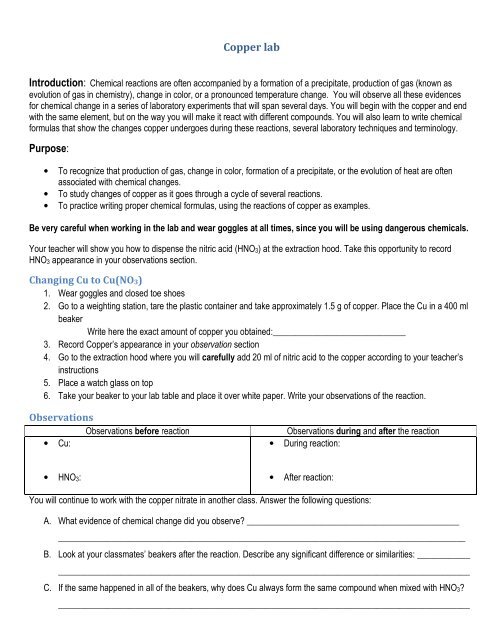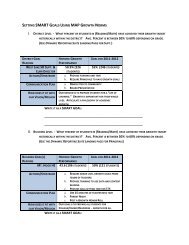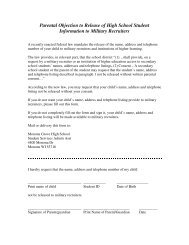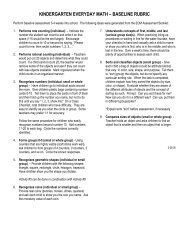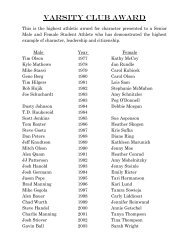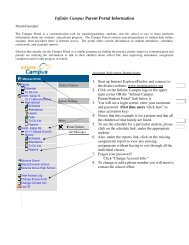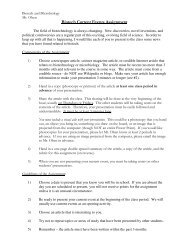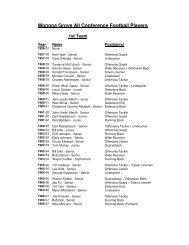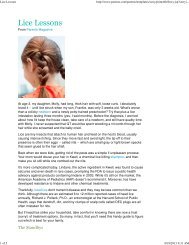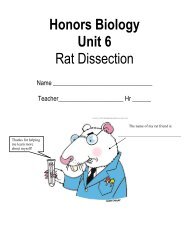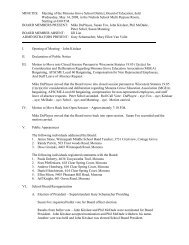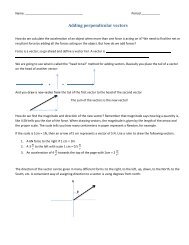Packet for Cu lab, naming and writing formulas, reaction types and ...
Packet for Cu lab, naming and writing formulas, reaction types and ...
Packet for Cu lab, naming and writing formulas, reaction types and ...
Create successful ePaper yourself
Turn your PDF publications into a flip-book with our unique Google optimized e-Paper software.
Copper <strong>lab</strong><br />
Introduction: Chemical <strong>reaction</strong>s are often accompanied by a <strong>for</strong>mation of a precipitate, production of gas (known as<br />
evolution of gas in chemistry), change in color, or a pronounced temperature change. You will observe all these evidences<br />
<strong>for</strong> chemical change in a series of <strong>lab</strong>oratory experiments that will span several days. You will begin with the copper <strong>and</strong> end<br />
with the same element, but on the way you will make it react with different compounds. You will also learn to write chemical<br />
<strong>for</strong>mulas that show the changes copper undergoes during these <strong>reaction</strong>s, several <strong>lab</strong>oratory techniques <strong>and</strong> terminology.<br />
Purpose:<br />
• To recognize that production of gas, change in color, <strong>for</strong>mation of a precipitate, or the evolution of heat are often<br />
associated with chemical changes.<br />
• To study changes of copper as it goes through a cycle of several <strong>reaction</strong>s.<br />
• To practice <strong>writing</strong> proper chemical <strong>for</strong>mulas, using the <strong>reaction</strong>s of copper as examples.<br />
Be very careful when working in the <strong>lab</strong> <strong>and</strong> wear goggles at all times, since you will be using dangerous chemicals.<br />
Your teacher will show you how to dispense the nitric acid (HNO3) at the extraction hood. Take this opportunity to record<br />
HNO3 appearance in your observations section.<br />
Changing <strong>Cu</strong> to <strong>Cu</strong>(NO3)<br />
1. Wear goggles <strong>and</strong> closed toe shoes<br />
2. Go to a weighting station, tare the plastic container <strong>and</strong> take approximately 1.5 g of copper. Place the <strong>Cu</strong> in a 400 ml<br />
beaker<br />
Write here the exact amount of copper you obtained:______________________________<br />
3. Record Copper’s appearance in your observation section<br />
4. Go to the extraction hood where you will carefully add 20 ml of nitric acid to the copper according to your teacher’s<br />
instructions<br />
5. Place a watch glass on top<br />
6. Take your beaker to your <strong>lab</strong> table <strong>and</strong> place it over white paper. Write your observations of the <strong>reaction</strong>.<br />
Observations<br />
Observations be<strong>for</strong>e <strong>reaction</strong><br />
• <strong>Cu</strong>:<br />
Observations during <strong>and</strong> after the <strong>reaction</strong><br />
• During <strong>reaction</strong>:<br />
• HNO3:<br />
• After <strong>reaction</strong>:<br />
You will continue to work with the copper nitrate in another class. Answer the following questions:<br />
A. What evidence of chemical change did you observe? ________________________________________________<br />
____________________________________________________________________________________________<br />
B. Look at your classmates’ beakers after the <strong>reaction</strong>. Describe any significant difference or similarities: ____________<br />
_____________________________________________________________________________________________<br />
C. If the same happened in all of the beakers, why does <strong>Cu</strong> always <strong>for</strong>m the same compound when mixed with HNO3?<br />
_____________________________________________________________________________________________


